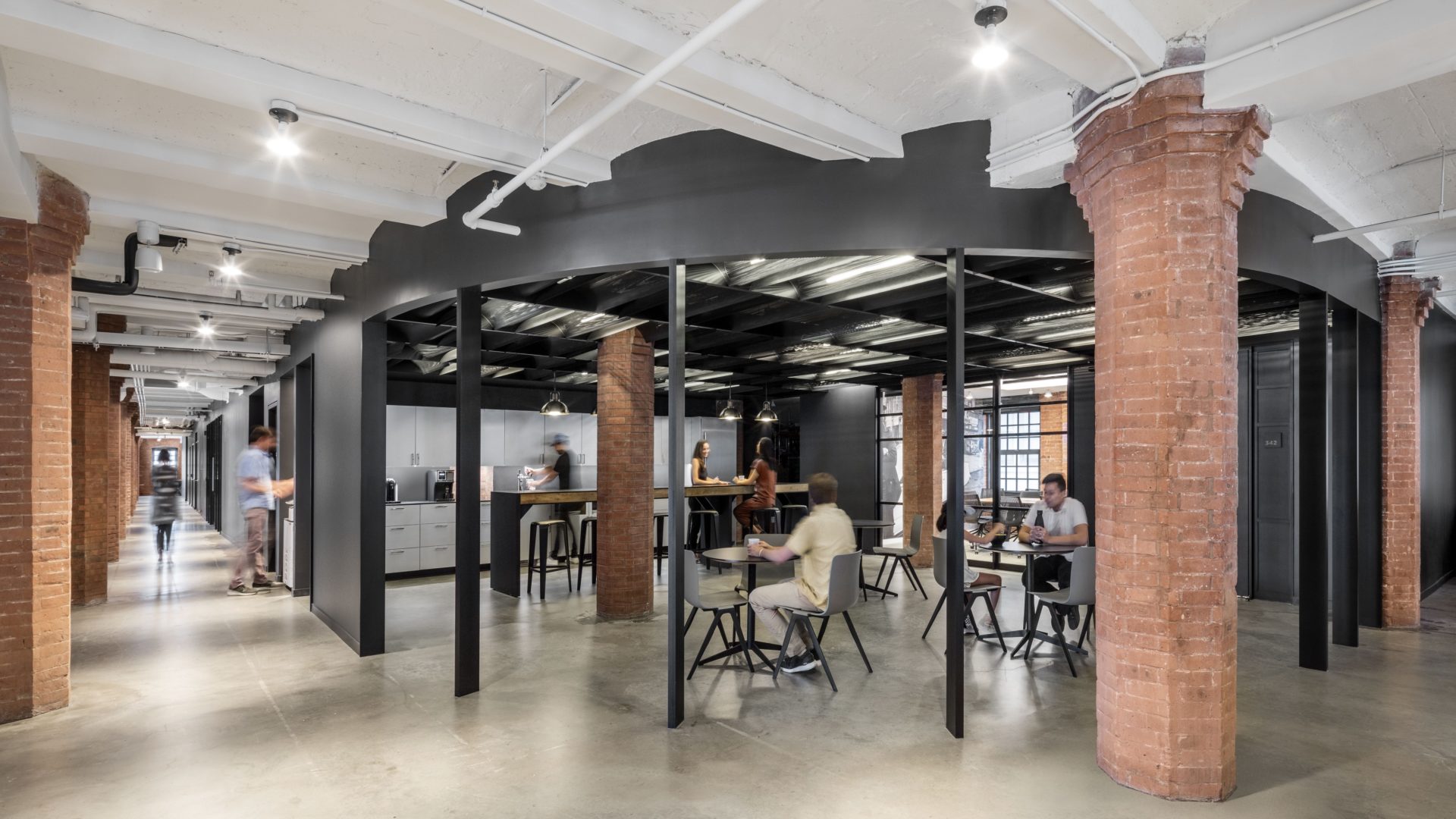Introducing The Future of Work
 Read Below
Read Below
 Read Below
Read Below
The office of NYC-based creative agency Translation, designed by Pophouse and vonDALWIG.
Introducing The Future of Work
Welcome to the first in our series of articles about the Future of Work. In addition to large-scale health and economic challenges, the coronavirus pandemic has created sudden, unplanned-for and drastic changes in the workplace. As thought leaders and creative problem-solvers in the field of interior design, our goal at Pophouse is to offer insights into the challenges that lie ahead and to guide our readers through a range of solutions for both the short and long terms. This article serves to introduce ourselves and provide an overview of the issues we feel need to be thoughtfully addressed, especially as stay-at-home mandates are starting to be eased throughout the country and people may soon be returning to the office. Future articles will delve deeper into specific topics that we believe will help you determine which concrete actions are best for your business moving forward.
Known for creating transformational spaces for clients in the commercial, hospitality and retail industries, Pophouse is a Detroit-based interior design studio that creates unconventional and human-centric design. Our team consists of interior, industrial and environmental designers and strategists who focus on the potential of design’s positive effect on people and businesses. By leveraging industry research with business acumen, we create meaningful strategies that inform our approach. Our clients understand the impact design can have on the culture, productivity and performance of their work environments. We are here to showcase our combined knowledge, experience and creativity to help you navigate the difficult waters that lie ahead.

Pre-Pandemic Trends
Office space design began taking a new direction at the start of the 21st Century. The big offices of the 1980’s began to give way to an open-office concept for both economic and workplace culture reasons. This open environment affected the amount of privacy and personal space provided for each worker, which began to decrease as companies switched to open office plans. In fact, the amount of space per employee has gone down from 211 square feet in 2009 to less than 125 square feet in 2019. In addition to benefiting from the cost-effectiveness of bench-style workstation configurations, many decision-makers believed that in order for teams to be productive, workers needed to be both in the office and also be in close physical proximity to each other and to their supervisors.
With the ability to fill offices with more workers, as recently as 2018, 44% of global companies did not allow remote work, based on research reported on by Forbes. Before the pandemic, approximately 4% of U.S. employees worked from home. According to Global Workplace Analytics, a research-based consulting firm dedicated to preparing employers for the future of work, now more than half the U.S. workforce, or 62.5 million, are doing so.
Because of the pandemic, America is inadvertently conducting the largest work-from-home experiment in history. We at Pophouse believe this phenomenon has created the equivalent of ten years of change in how we work in a very short period of time. Leaders who did not believe that allowing employees to work from home was productive are now being forced to confront the issue. This presents an enormous opportunity to reconsider many issues from a design perspective and adapt accordingly, particularly as offices start to reopen. Workers who have become accustomed to the convenience of working from home may be reluctant to return to the workplace. In addition, they may no longer be tolerant of working shoulder-to-shoulder with fellow employees and will welcome the changes mandated by new rules and regulations if properly executed.
The New Normal
“We’re discovering that business leaders who did not think it was possible for their teams to be successful working remotely are beginning to change their minds,” said Jennifer Janus, President of Pophouse. “Some of our clients are telling us they have seen even more productivity than before the pandemic, realizing that telecommuting is not only possible, it may be beneficial.” According to Forbes, studies have shown that employees with work-from-home arrangements were 4.4% more productive. A FlexJobs study discovered that 76% of those questioned said they would be less likely to switch jobs if they continued to have a flexible work arrangement. Lingering trust issues are dissipating, with the idea that workers need to be given the opportunity to demonstrate what they can do.

We are also seeing that employees are quick to adapt to the technology that enables them to work remotely. Enterprise video communication platforms, including Microsoft Teams, GoToMeeting and Zoom, existed prior to the pandemic, but only now are people comprehending the scope of services they provide and realizing how well they actually function. This technology makes it possible for team members to communicate through video and audio conferencing, with the ability to collaborate, chat and attend webinars from mobile devices, desktops and telephones.
Returning to the Office
With employees returning to the workplace in the foreseeable future, we urge companies to reevaluate their current work-from-home situation and be prepared to make changes, both in their policies as well as their office design. This requires considering the reason people come to an office in the first place as well as redesigning their office space to make it as functional as possible. We see this as an opportunity for companies to create a physical and virtual work environment that supports team culture and collaboration, two concepts that are important when considering the future of the office. This includes a virtual-first environment that takes into account how team members in the office can effectively collaborate with those who are working remotely.
We believe it is crucial to analyze and document the activities that are essential to promote connectivity and culture in the workplace, such as ensuring there are sufficient areas for team members to meet and interact. A thoughtful examination should inevitably lead to finding a balance for all office activities as well as the right amount of space for the future design of the office. Because there is the real possibility that more people will be working from home on a regular basis, we foresee the need for more flexibility in the office layout to accommodate the expansion and contraction of the workforce, including specialized areas for specific tasks such as small group conversations and larger areas for events. We advocate creating comfortable spaces that foster personal connection and collaboration, in the hopes of attracting workers back to the office.
It is estimated that almost 50% of the workforce in the U.S. has a job that can be performed at least partially at home. Global Workplace Analytics estimated that by the end of 2021, at least 25% of the workforce will work remotely. As a result, businesses now have the opportunity to reevaluate their real estate footprint and potentially lower costs during this time of uncertainty. Finally, we believe companies must invest in expanded as well as improved technology to accommodate those workers who telecommute.

Improving the Working Environment at Home
The comfort and quality of the work environment in people’s homes is as important as it is in the office. Ergonomic and commercial-grade home office set-ups will enhance team members’ well-being and increase their productivity. So, in tandem with redesigning the office, now is the time to invest in workers’ remote workspaces for the benefit of all.
Working remotely also has the ability to enhance employees’ well-being and promote a healthy balance between work and personal life. In addition, eliminating the stress of commuting provides more time for self-care and quality time with family, resulting in a happier workforce.
Looking Ahead
We hope this article is an incentive for you to consider what the future of your office will look like and to devise an action plan. Keep an eye out for our upcoming articles addressing pertinent issues such as economical ways to maintain and improve company culture and how to design for the post-pandemic workspace, which will inevitably include paying close attention to the need for social distancing. If you are interested in a personalized review of your current workplace layout or your employees work from home settings, send your inquiry to bizdev@pophouse.design.
Next Story
